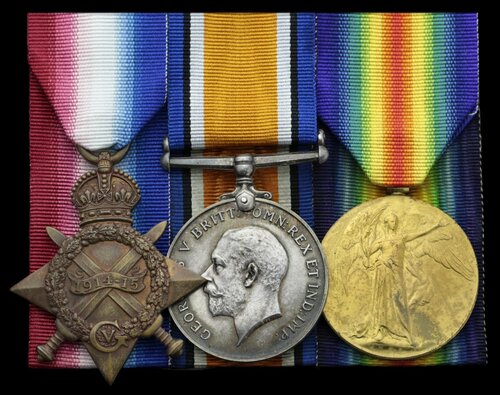
Auction: 22001 - Orders, Decorations and Medals
Lot: 231
Three: 2nd Lieutenant C. M. Sing, 7th Battalion, Royal Sussex Regiment, late 10th (Stockbrokers) Battalion, Royal Fusiliers, who served as an Assistant Native Commissioner to North Rhodesia, a sniper with the Royal Fusiliers only to be mortally wounded on 7 July 1916 during an attack at Ovillers where he had been commanding a Lewis machine-gun section.
1914-15 Star (Stk-1112 L.Cpl C. M. Sing. R. Fus:); British War and Victory Medal (2. Lieut. C. M. Sing), mounted for display, very fine (3)
Charles Millington Sing was born at Brighton, Sussex on 9 February 1889, the son of Reverend Edward and Sarah Synge of Rothe, Lyme Regis, Dorset. He was educated first at Haileybury School from 1903-1907, where he was a member of the shooting team, before moving on to Christs College, Cambridge in 1907. Having studied the Law Sing was appointed Assistant Native Commissioner in North Rhodesia in 1911. He happened to have returned to England on leave prior to the outbreak of war, sailing on the Kenilworth Castle via Madeira and arriving on 7 July 1914. On the outbreak of war he enlisted with the Royal Fusiliers on 29 August 1914 being posted to 10th (Stockbrokers) Battalion, Royal Fusiliers as a Private. Appointed Lance Corporal just prior to deployment on 24 July 1915 he then entered the war in France on 31 July. His role with the Battalion seems to have been that of a sniper as noted in an obituary for him in The Times on 11 August 1916 'his marksmanship made him valuable as a sniper'.
Sing's abilities earned him a recommendation for Commission and a place at a Cadet School on 2 February 1916. As a result he was promptly Commissioned 2nd Lieutenant on 3 April 19 March 1916 and posted to the 7th Battalion, Royal Sussex Regiment. This unit along with the 8th and 9th Battalions, Royal Fusiliers were part of an attack on the village of Ovillers. Sing was to command the Lewis gun section for the attack and led his men forward into a hail of German fire. It seems that at some stage during the attack he was wounded, the testimony of the inquiry as to his whereabouts takes up the story:
'Pte Allsop now in 1st London Hospital Camberwell says that he helped to carry 2nd Lieut S. M. Sing after he was wounded at 8:30 am on 7th July 1916 into a shell-hole for greater safety and that 2nd Lieut Sing lived about 3 hours after.'
Sing does not appear to have been idle even with his injuries and continued to give orders:
'Your nephew was seen lying wounded in a shell-hole between the lines as we advanced, one of his men spoke to him. 2nd Lt. Sing raised himself and gave the man instructions as to how to carry on & then he is stated to have collapsed.'
However these injuries however severe were not what killed him as is attested to by Sergeant Prevett is reported to have who stated:
'Mr Sing was lying wounded in the same shell hole as a Mr Gordon who was killed and a C/cpl [SIC] Chevis who has since died of wounds. These three were in the shell gole when another shell came over, killed Mr Gordon, wounded Chevis for the 2nd time and severely wounded Mr Sing.'
As the British held the ground they had fought for that day they could confirm that Sing was not a German prisoner but had indeed died in the shell-hole of the wounds he sustained that day. His body was not immediately identified however the Commonwealth War Graves Commission states that he is buried in Serre Road Cemetery No.2 suggesting that his remains were later identified; sold together with copied research including handwritten notes, service papers and Commonwealth War Graves as well as an M.I.C., an extract relating to the Royal Sussex Regiment on the Somme and Haileybury Register.
Subject to 20% VAT on Buyer’s Premium. For more information please view Terms and Conditions for Buyers.
Sold for
£280
Starting price
£140




